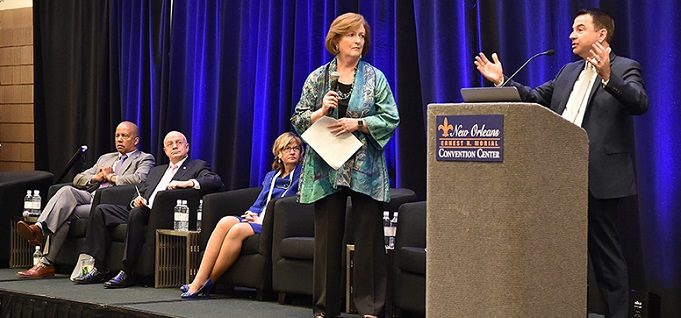Early challenges, successes, on guided pathways
By CC Daily Staff
April 25, 2017
Community colleges engaged in creating guided pathways for students are facing some expected challenges — from difficult conversations with faculty, to improving career counseling — but the changes are yielding results, even early on in their efforts.
Leaders of several community colleges involved in pathways — including institutions new to the effort, as well as those that have already laid the ground with similar efforts over the past decade — shared their experiences during a session on pathways at the American Association of Community Colleges (AACC) annual convention.
“The work of pathways reform is burgeoning around the country,” said Kay McClenney, a senior advisor to the president of AACC who is leading AACC’s Pathways Project.
Many of the 30 two-year colleges selected to participate in the Pathways Project are “going all in” and making progress toward developing the structures for pathways at their institutions, according to a report released last week by the Community College Research Center, one of the partners on Pathways.
At Sunday’s spotlight session, college leaders highlighted efforts at their institutions, from gathering and analyzing data, to better preparing students for college through orientation and first-year experience programs.
One common thread among the presenters was their emphasize on the importance of involving faculty and staff, from having them champion the effort, to helping create academic pathways (also called meta-majors), which often includes the difficult conversation of which programs to eliminate.
Brenda Hellyer, chancellor of the San Jacinto College District (SJCD) Texas, emphasized the importance of faculty involvement. Like other colleges in the Pathways Project, SJCD nixed late registration and created mandatory orientation for new students among its initial changes. Now, it’s in the heavier work of creating the pathways, with the goal of having all new students in fall 2018 in a pathway.
“There is no part of our institution that will not be affected by this,” Hellyer said.
Focus on advising
Some colleges have focused on improving advising by hiring more advisors, who are helping students select a pathway and stay on it. For example, the Community College of Philadephia has embedded career advisors among its seven meta-majors.
Miami Dade College (MDC) in Florida created a three-tier advisement process that includes advisors assigned to all area high schools to help students, families and even teachers become familiar with college requirements. MDC students then have an academic advisor assigned to help them through the first quarter of their degree completion. After that, a faculty mentor is assigned to the student. So far, the college has some 450 faculty mentors, all of whom do so voluntarily, though the college does provide incentives.
Several colleges using the guided pathways model are already yielding promising results. Lorain County Community College in Ohio has seen a 48 percent increase in associate degrees over the last five year, according to President Marcia Ballinger. At MDC, black and Hispanic students have graduated at a higher rate over the past four years than the average student body, noted its president, Eduardo Padrón.
“This work is hard. It has to be intentional. You have to believe it,” Padrón said.
There’s more to the story. Check out the full article at CC Daily.


